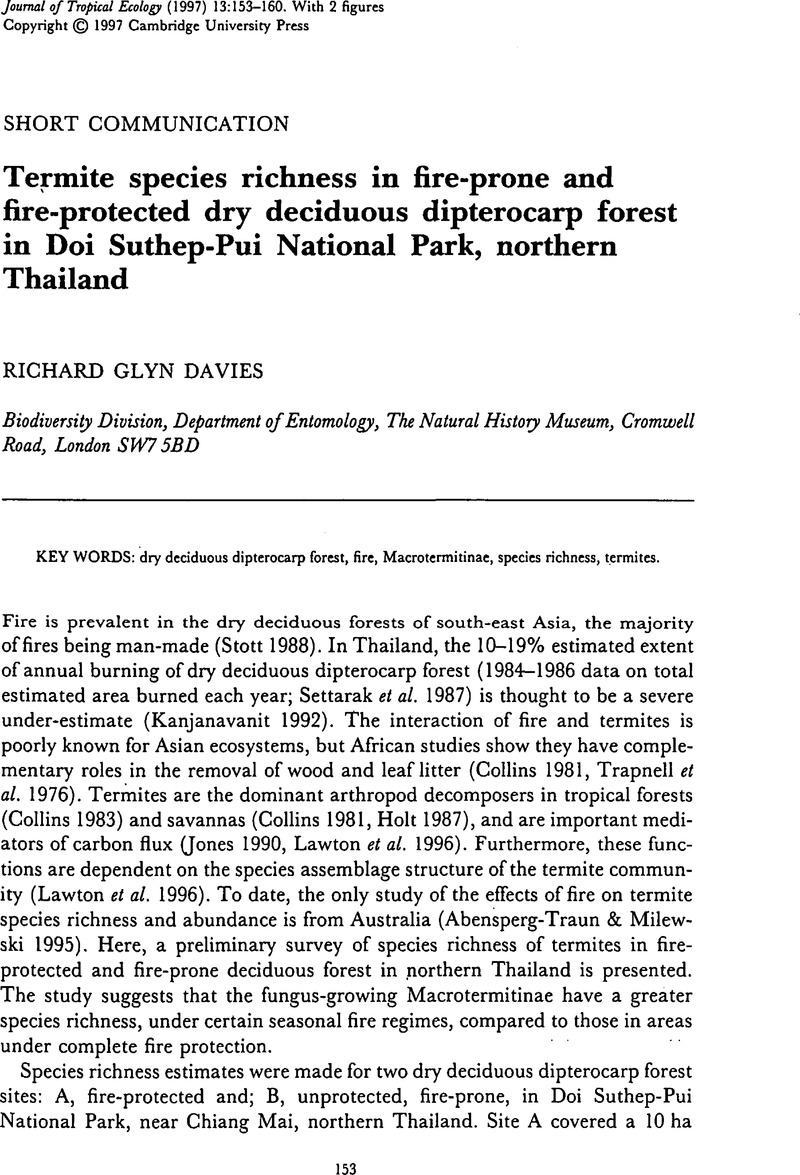Crossref Citations
This article has been cited by the following publications. This list is generated based on data provided by Crossref.
Dibog, L.
Eggleton, P.
Norgrove, L.
Bignell, D.E.
and
Hauser, S.
1999.
Impacts of canopy cover on soil termite assemblages in an agrisilvicultural system in southern Cameroon.
Bulletin of Entomological Research,
Vol. 89,
Issue. 2,
p.
125.
Newbery, D. M.
Clutton–Brock, T. H.
Prance, G. T.
Eggleton, P.
Homathevi, R.
Jones, D. T.
MacDonald, J. A.
Jeeva, D.
Bignell, D. E.
Davies, R. G.
and
Maryati, M.
1999.
Termite assemblages, forest disturbance and greenhouse gas fluxes in Sabah, East Malaysia.
Philosophical Transactions of the Royal Society of London. Series B: Biological Sciences,
Vol. 354,
Issue. 1391,
p.
1791.
GATHORNE-HARDY, F. J.
JONES, D. T.
and
MAWDSLEY, N. A.
2000.
The recolonization of the Krakatau islands by termites (Isoptera), and their biogeographical origins.
Biological Journal of the Linnean Society,
Vol. 71,
Issue. 2,
p.
251.
Jones, David T.
and
Eggleton, Paul
2000.
Sampling termite assemblages in tropical forests: testing a rapid biodiversity assessment protocol.
Journal of Applied Ecology,
Vol. 37,
Issue. 1,
p.
191.
Eggleton, Paul
2000.
Termites: Evolution, Sociality, Symbioses, Ecology.
p.
25.
Lepage, Michel
and
Darlington, Johanna P. E. C.
2000.
Termites: Evolution, Sociality, Symbioses, Ecology.
p.
333.
Donovan, Sarah E.
Eggleton, Paul
and
Martin, Andy
2002.
Species composition of termites of the Nyika plateau forests, northern Malawi, over an altitudinal gradient.
African Journal of Ecology,
Vol. 40,
Issue. 4,
p.
379.
GATHORNE-HARDY, F. J.
SYAUKANI
DAVIES, R. G.
EGGLETON, P.
and
JONES, D. T.
2002.
Quaternary rainforest refugia in south-east Asia: using termites (Isoptera) as indicators.
Biological Journal of the Linnean Society,
Vol. 75,
Issue. 4,
p.
453.
DOI, Ryoichi
and
SAKURAI, Katsutoshi
2003.
Soil environmental factors relating to diversity of culturable soil bacterial communities in the Sakaerat Environmental Research Station, Thailand.
Tropics,
Vol. 12,
Issue. 3,
p.
185.
Takamura, Kenzi
2003.
Pasoh.
p.
521.
Davies, Richard G.
Eggleton, Paul
Jones, David T.
Gathorne‐Hardy, Freddy J.
and
Hernández, Luis M.
2003.
Evolution of termite functional diversity: analysis and synthesis of local ecological and regional influences on local species richness.
Journal of Biogeography,
Vol. 30,
Issue. 6,
p.
847.
Cleary, Daniel F.R.
2003.
An examination of scale of assessment, logging and ENSO-induced fires on butterfly diversity in Borneo.
Oecologia,
Vol. 135,
Issue. 2,
p.
313.
Esslinger, Theodore L.
2005.
Recent Literature on Lichens—197*.
The Bryologist,
Vol. 108,
Issue. 2,
p.
301.
Varma, R. V.
and
Swaran, P. R.
2007.
Diversity of termites in a young eucalypt plantation in the tropical forests of Kerala, India.
International Journal of Tropical Insect Science,
Vol. 27,
Issue. 2,
p.
95.
Traoré, Saran
Nygård, Robert
Guinko, Sita
and
Lepage, Michel
2008.
Impact of Macrotermes termitaria as a source of heterogeneity on tree diversity and structure in a Sudanian savannah under controlled grazing and annual prescribed fire (Burkina Faso).
Forest Ecology and Management,
Vol. 255,
Issue. 7,
p.
2337.
Dosso, Kanvaly
Konaté, Souleymane
Aidara, Daouda
and
Linsenmair, K. E.
2010.
Termite diversity and abundance across fire-induced habitat variability in a tropical moist savanna (Lamto, Central Côte d'Ivoire).
Journal of Tropical Ecology,
Vol. 26,
Issue. 3,
p.
323.
Hanula, James L.
Ulyshen, Michael D.
and
Wade, Dale D.
2012.
Impacts of Prescribed Fire Frequency on Coarse Woody Debris Volume, Decomposition and Termite Activity in the Longleaf Pine Flatwoods of Florida.
Forests,
Vol. 3,
Issue. 2,
p.
317.
Olejniczka, Izabella
Russel, Stefan
and
Prędecka, Anna
2014.
Reakcja mezofauny (Collembola and Acarina) zamieszkująca łąki na mineralnych i organicznych glebach, na wiosenne doświadczalne pożary.
Studia Ecologiae et Bioethicae,
Vol. 12,
Issue. 3,
p.
121.
Neoh, Kok‐Boon
Bong, Lee‐Jin
Muhammad, Ahmad
Itoh, Masayuki
Kozan, Osamu
Takematsu, Yoko
and
Yoshimura, Tsuyoshi
2015.
Understanding the impact of fire on termites in degraded tropical peatlands and the mechanisms for their ecological success: current knowledge and research needs.
Ecological Research,
Vol. 30,
Issue. 5,
p.
759.
Avitabile, Sarah C.
Nimmo, Dale G.
Bennett, Andrew F.
Clarke, Michael F.
and
Yang, Jian
2015.
Termites Are Resistant to the Effects of Fire at Multiple Spatial Scales.
PLOS ONE,
Vol. 10,
Issue. 11,
p.
e0140114.



